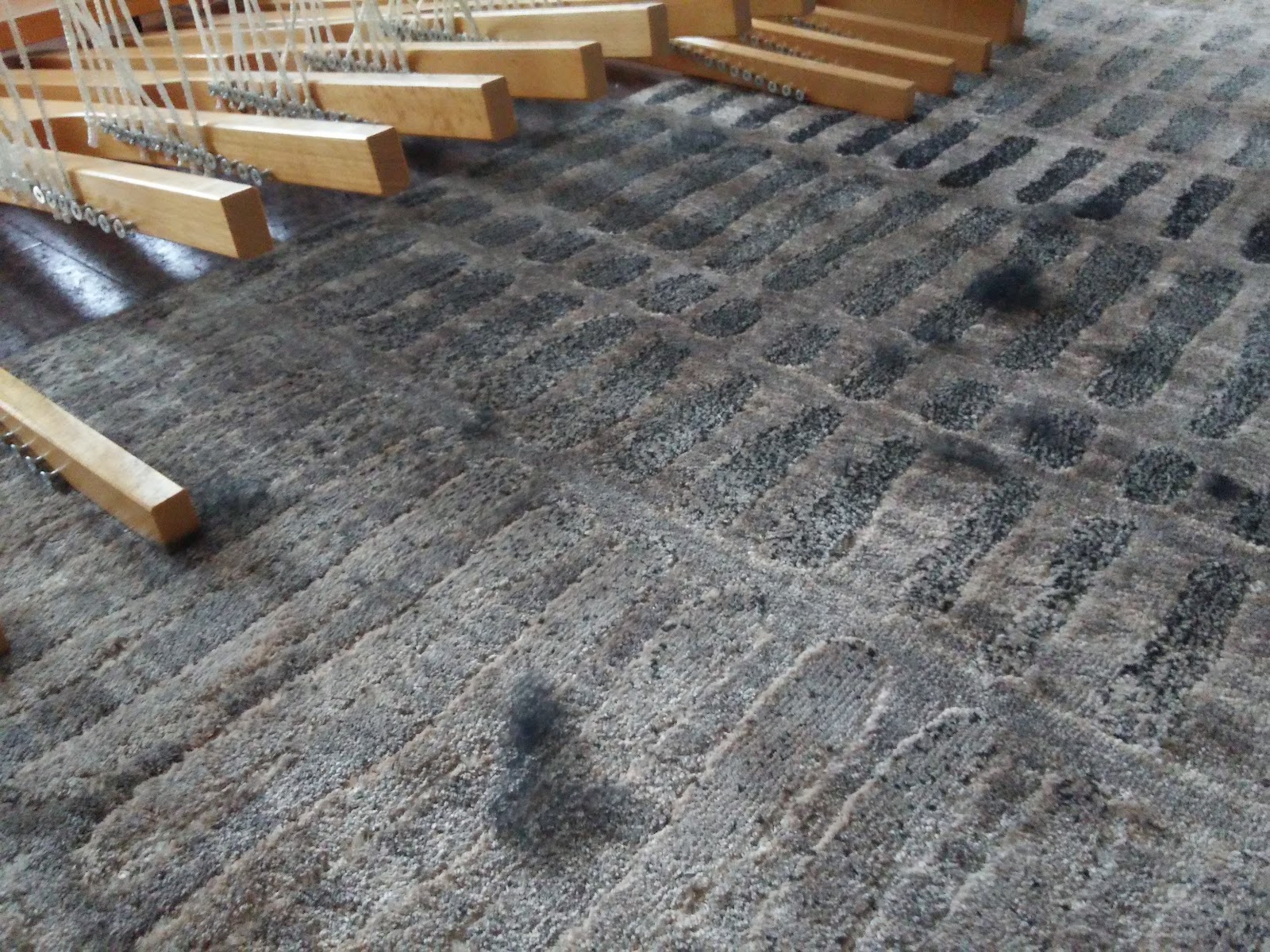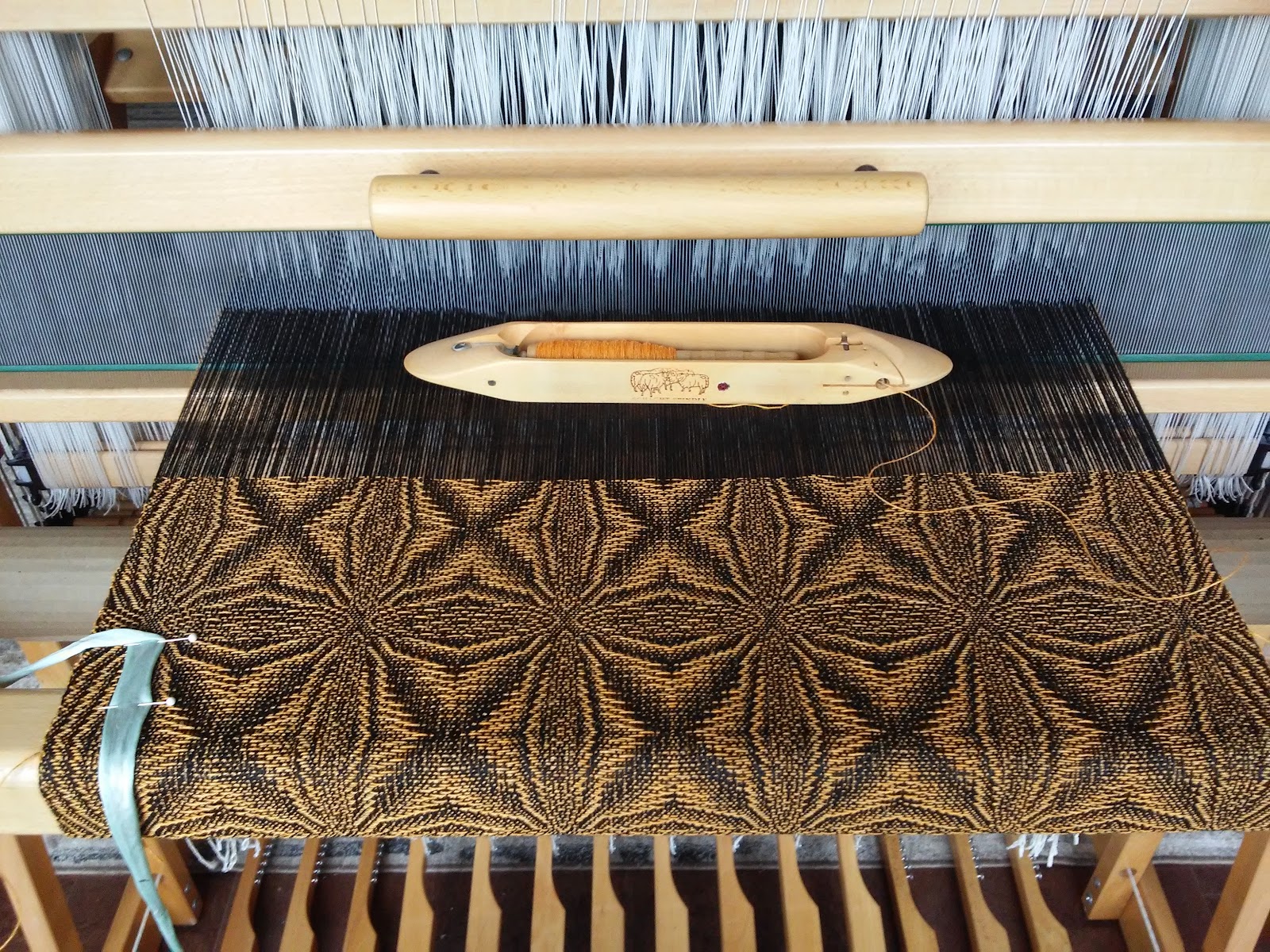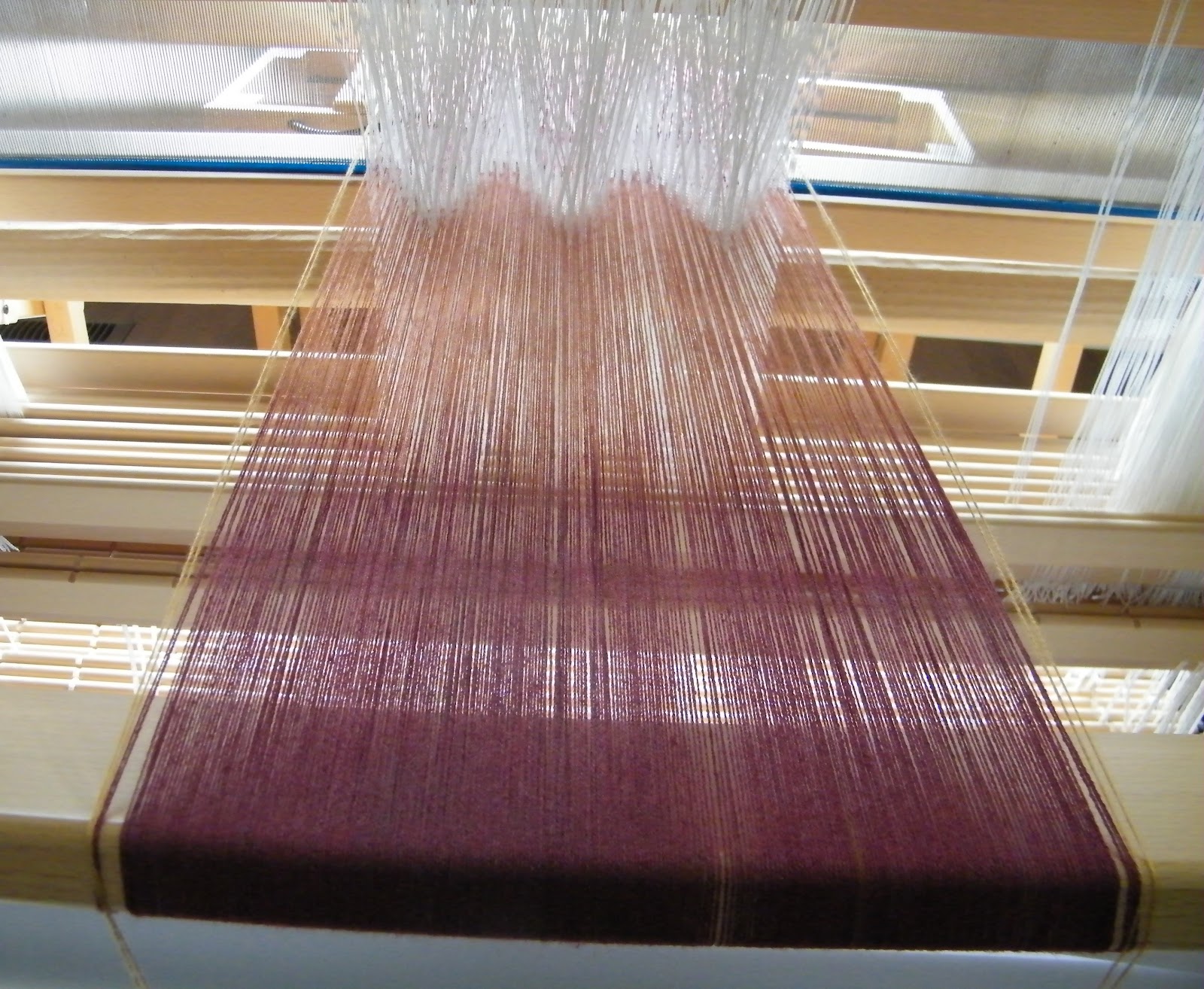I finally started the last of the 2/22 black cottolin runners. For the last runner the weft is 2/22 purple cottolin. I also decided to change up the pattern, it is the inverse of the original pattern. It is now a pattern of diamonds instead of X’s.
It wove up quite quickly and I was able to cut all the runners off and all that is left by the loom is some dust bunnies hiding in plain sight!I’ve washed and given the runners their first press. I’ve folded and pinned the hems ready for hand sewing but it has been very foggy lately so I need to wait for some sunshine to finish the runners. I’ve taken some photos (with the pins in hem). First runner is 2/22 beige and black cottolin, it is about 67 inches long and 18 inches wide. The graphic punch of the X’s make for a lovely modern table runner.The second runner is 2/16 gold ramie and 2/22 black cottolin, it is about 50 inches long and 20 inches wide. It is the widest runner by 2 inches! I had to take the photo with the lights on so the colour of the gold ramie isn’t quite right but in real life the colour is stunning.The third and final runner is 2/22 purple and black cottolin, it is 53 inches long and 18 3/4 inches wide. The diamonds are just as lovely to the X’s in my humble opinion.The autumn crackle silk scarf is up on Etsy. For Sale.Final Garden Photo is seed heads for the Echinacea purpurea 'Green Twister' with a white crowned sparrow who just loves them. Don't let the cuteness fool you he also likes to eat my blueberries!Pages
Wednesday, December 20, 2023
Monday, December 4, 2023
Black Cottolin Table Runners on 8 Shafts
The warp for the table runners is 2/22 black cottolin is 6 yards and 12 inches long. The plan is to weave 2 runners at about 50 inches and 1 runner at 70 inches. For the weft of the first runner I used 2/22 cottolin in a beige linen colour and I wove that one to 70 inches with added hems of 4.5 inches. The second runner is 2/16 gold ramie.
I just finished the gold ramie runner it was woven to 50 inches with added hems of 4.5 inches. It wasn’t a pleasure to weave, the draw of the ramie in the end feed shuttle was sticky and hard. Also there was a lot of knots in the cone of ramie so lots of starting and stopping to put in new pirns.There is only one runner left to weave, it should be 50 inches but looking at the back beam it feels like there is a lot of warp still left. I found a lovely blue/green silk with flecks of brown that I thought would look spectacular with the black warp.
I tried it out and it just died against the black. All the colour was washed away and it just looked grey and blah. I was really hopeful about this weft, so I actually left it overnight to see if it would look better in the morning sun. Nope.
Next I tried a bright red and royal purple both 2/22 cottolin. They both work but I felt that the red was a little aggressive and I wasn’t sure if it would be all that nice to live with on a dining room table. So the purple is the winner. I haven’t started the purple runner yet so no photos.
Someone asked if we leave the trial weft colours in the warp and that becomes waste or do you take them out. We take them out, the audition weft aren’t even taken off the cones.
Final photos are of another botany walk at a local park, it is surprising how green and lush the forest is looking in early December.
The walk took us along a stream and ended at the ocean looking over to the snow peaked coastal mountain range on the mainland of British Columbia.
Monday, November 27, 2023
12 Shaft Advancing Silk Scarf
Another week, another painted silk scarf, another conundrum; this seems to be the never ending theme of my weaving life.
I picked a lovely teal and purple warp because I thought it would be any easy one to find a weft for and this could not have been more wrong! But, I’m getting ahead of myself because the first thing I do is pick the pattern I’m going to weave.
The 12 Shaft Advancing Twill draft has large diamonds and has quite a large repeat of 95 threads. It is amazingly pretty and gives spots of weft, spots of warp and a definite diagonal.
Ngaire wove this scarf a while ago and I thought it was time for a re-visit. Ngaires full post can be found here.
Now that I had the painted warp chosen and the pattern, now choosing the weft for the scarf.
I lined up the first of the possible candidates: magenta, dark teal, eggplant, light teal and mauve. I draped the warp over them and was able to delete a couple right away.
I was down to dark teal, magenta and mauve and these I took to the loom to trial out.
I wove a few picks of each and just for the heck of it I added silver. The dark teal made the purple look brown, so no to that one. The magenta was exciting, but took over the whole scarf, again a big no. The silver made the warp fade into the background, a resounding no. The mauve was the only choice for me. It made the warp colour show through and rosey’d up the purple.
We have been in a November fog for days now, so getting a photo has been a challenge, it is so, so grey outside! Here is an early photo of the scarf showing the lovely shine as it goes over the breast beam.
And another from a slightly different angle.
Now that gardening season over for awhile, time to hit the knitting needles. This is my latest project using hand spun natural merino and hand spun merino/silk blend in dark purple. I’m quite pleased with it and I know it will look even better once I block it. The pattern is called FARA Hat, by Anniki Leppik and I bought the pattern on Ravelry.
Monday, November 20, 2023
Twill Table Runners on 8 Shafts
After threading the black 2/22 cottolin for the table runners, the next step is to pick the weft for them. I choose to weave the 70 inch runner first so I wanted to pick a classic colour combination, black and beige. I had two choices of colours in 2/22 cottolin, a more linen-y beige and a more cotton-y beige.
I went with the linen-y colour, but it looks quite grey in the photo. I have done this pattern for years, it is an absolute favourite but I still take a photo of the end of the hem and the start of the pattern just to make sure that the other end of the table runner will match!Surprisingly the picture above is the only photo that I took of the runner! It wove up quickly and easily. By the end of the runner I was starting to notice that the left hand side of the warp was getting a little spongy and loose. I could really see the distortion when I started the new runner.
I unwove the start of the new runner and I added pipe insulation (or pool noodle) to the back of the warp beam. It allows the warp to even out the tension by allowing the tighter threads to bite into the pipe insulation to give some ease of tension.
It works but the pipe insulation likes to move forward with the warp as you are advancing the warp so I have to get up and push the pipe insulation back into position every time, it is a little annoying.
For the second runner I choose a bright gold 2/16 ramie, ramie is a bast fibre made from a plant in the nettle family. Again, here is the start of the runner just in case I need to refer back to it to correctly end the runner.
Some of you eagle eyed people may have noticed that I’ve changed my shuttle, the ramie needed to have a different tension in the shuttle than the 2/22 cottolin that I had used for the previous runner. The ramie is quite stiff and a little sticky so the draw from the shuttle is a bit ‘hard’, it isn’t that nice to weave with but the runner is stunning. I’m happy that the runner is only going to be 50 inches, though!
This summer we’ve been hearing the call of a pacific tree frog (Pseudacris regilla) also called the pacific chorus frog, in the back garden and last week I found it hiding under some pots by the greenhouse. It is only about 5 cm long (about 2 inches) super cute and quite noisy!
Monday, November 13, 2023
10 Shaft Crackle Silk Scarf for Autumn
My autumn crackle scarf is off the loom today, and I’m totally chuffed!
This scarf has been a joy to weave right from the beginning. The colours of the silk were so inspiring and I loved seeing the foreshadowing of the pattern from the back of the loom.Notice the floating selvedges? On my last few projects I have doubled the floating selvedges on each side to give added presence to the edges and to help negate fraying. It seems to have worked and I will continue to use a doubled floating selvedges when using silk and tencel.The gold weft really is working well with all of the different colours in the warp, it contrasts beautifully with the burgundy and the olive and when it hits the brown portion, it just gleams like silk should.The crackle trellis pattern was a really lovely weave, it is treadled as an advancing twill with fairly short runs that are woven from 1 – 10 and then reversed from 10 – 1.I wove right up to the end of the warp and frankly couldn’t get any shed at all by the end of it. I just managed to get 70 inches with the tension off. I expect that I will end up with a scarf between 67 and 69 inches.
Here is the scarf right off the loom in our very weak November sunshine.Same scarf and hour later in much stronger sun.The last two silk scarves have had their final photos taken and now are up on the store, WovenBeauty, on Etsy. The first is the yellow and blue scarf, For Sale.
The second is the blue polka dots with the centre panel of pink and orange silk, For Sale.
Monday, November 6, 2023
Taking a 'brake'
I’ve put on a new project, and no, it's not another painted silk warp! It is a project that will use a different reed. We share the 14-15 dent reed so I decided that it would be a good idea to do something completely different. There is some black 2/22 cottolin that has just been begging to be made into table runners. I pulled a warp that is 6 yards and 12 inches long, it should be long enough for one 70 inch runner and two 50 inch runners.
There was a bit of a disaster when we were pulling on the warp, there was a loud wooden thunk and a metallic twang from a spring. The brake for the cloth beam broke! The wire had frayed apart where it had been looped over the eye hook at the top of the picture. It was Friday afternoon when this happen so we sent an email to Louet to see if we can get a replacement.We were able to finish pulling on the warp without using the brake, but it was slow going. We’d pull on some of the warp and then lock the cloth beam with the lever and cog system. After locking the beam we could pull the warp and the paper separator to tighten the warp threads on the cloth beam.My Louet Spring I loom is one of the originals from the early 1990’s and on the Louet website everything has changed over to the new Spring II loom so we weren’t sure if they could help. But thankfully Mom also has a Louet Spring I loom that she got in 2008 and it has a slightly different brake set up than mine. There is a second eye hook in the brake lever and the wire is not looped together.My clever Dad was able to find 12 gauge braided wire, it is slightly bigger than the original braided wire and a 1 3/4 closed loop screw that perfectly fit the hole in the brake lever. The braided wire is looped at each end and is held by crimps. He had to go out and buy a Swaging tool to properly lock (cold weld) the swage sleeve to the braided wire. There is a lot of tension on the brake so it needs to be done right. The brake had been fixed by Sunday morning! The wire will stretch a bit so some fine tuning will be needed by using the upper eye hook.I’ve already started to thread the loom, ready for the next project! Oh, and this morning (Monday) we got an email back from Louet, but we were able to fix it ourselves!Final Garden Photo is some fall colour featuring the lime green leaves of the Golden Smoke Tree (Cotinus Coggyria 'Golden Sprite') which turns a lovely burgundy colour, the Maiden Grass (Miscanthus sinesis' Morning Light') is just starting to bloom and the bright red of the Red Bells Tree (Enkianthus 'campanulatus') makes it a highlight in the autumn garden.Monday, October 30, 2023
The Difference is in the Sett
I have just put the third of my hand painted silk warps on the loom. This time I’ve chosen to weave a 30/2 tussah silk warp painted in olive, plum and bronze, very autumnal.
When I am planning a project there are a few things that I need to know up front: the number of warp ends that I have to work with, and how close to sley the reed being the two most important.When I first started weaving I bought Mary E Black’s The Key to Weaving which I swear contains everything you need to know about weaving within its 698 pages. At the very end of the book in the appendix lies a sleying table with some common setts. This is a good, but dated chart of what was commonly used in the 1950’s.Mary Black’s table contains the grist, the fibre and setts for loose plain weave, firm plain weave and twill. For example 8/2 cotton is sett at 20 epi for loose plain weave, 24 for firm plain weave and 28 for twill. Years ago I put all of this information onto an Excel spreadsheet and I have been updating it with new information ever since including yards per pound and the sett for lace if I can find it. My chart states that 30/2 should be sett at 26 epi for loose plain weave, 32 epi for firm plain weave and 40 epi for twill. I looked at my reeds and chose to sley the cloth at 36 epi, so 3 per dent in a 12 dent reed.Once I had it sleyed I thought it looked a tad crammed, but I hoped that slimming down the weft would be the answer. I tried 10/2 tencel in red and 20/2 tencel in black and neither of them were good. The red tencel just fused into the back ground with the warp and the black tencel was too spidery.I thought that the warp just looked too tight overall.I decided to re-sley the warp at 30 epi, so 2 per dent in a 15 dent reed and I’m much happier with the look of the warp although the scarf will be a tad wider than anticipated since I had 256 ends of warp, I now have a 8 1/2 inch wide scarf.
The pattern I’ve chosen for this scarf is a 10 shaft Crackle weave grid and the weft I’ve chosen is 8/2 tencel in gold. Now I’ve just got to buckle down and weave it.Can you see them? We got 12 golf ball sized oranges off our wee tree and there is candied orange peel in our future.























































